Examining Yosemite’s diverse climate and its fascinating collections of trees
Within the 747,956-acre expanse of Yosemite National Park, ground elevation varies from as low as 2,105 feet at the Merced River to a towering 13,115 feet at the peak Mount Lyell, Yosemite’s highest point. This drastic change in elevation taking place within relatively few miles creates a diverse array of climates, giving way to a variety of different habitats, providing fertile grounds for a very unique and diverse array of trees.
Yosemite is home to 37 tree species, each of which grows mainly within a specific range of altitude.
This can be useful knowledge with backpacking in Yosemite, as identifying nearby trees can help hikers establish, give or take, the altitude at which they stand. Because each tree has its own set of climate requirements, their growth occurs in belts, with the most drought-resilient species occurring at the drier, lower elevation of the Sierra Nevada foothills, and the hardiest varieties, capable of withstanding the long, harsh alpine winters, occurring at higher altitude.
When asking what kind of trees grow in Yosemite, the most common answer is likely to relate to its cone-bearing conifers—the durable and iconic evergreens that comprise the bulk of Yosemite’s forest at higher elevations. But habitats in the lower-altitude areas of the park, such as Yosemite Valley, also host tree species that thrive in areas where most of their cone-bearing brethren cannot. Put them all together for a phenomenal assortment that is entirely unique to the granite wonderland of the Sierra.
To help you understand the types of trees you’ll see during your Yosemite visit, we put together some fun-facts and tips for identifying the Trees of Yosemite National Park.
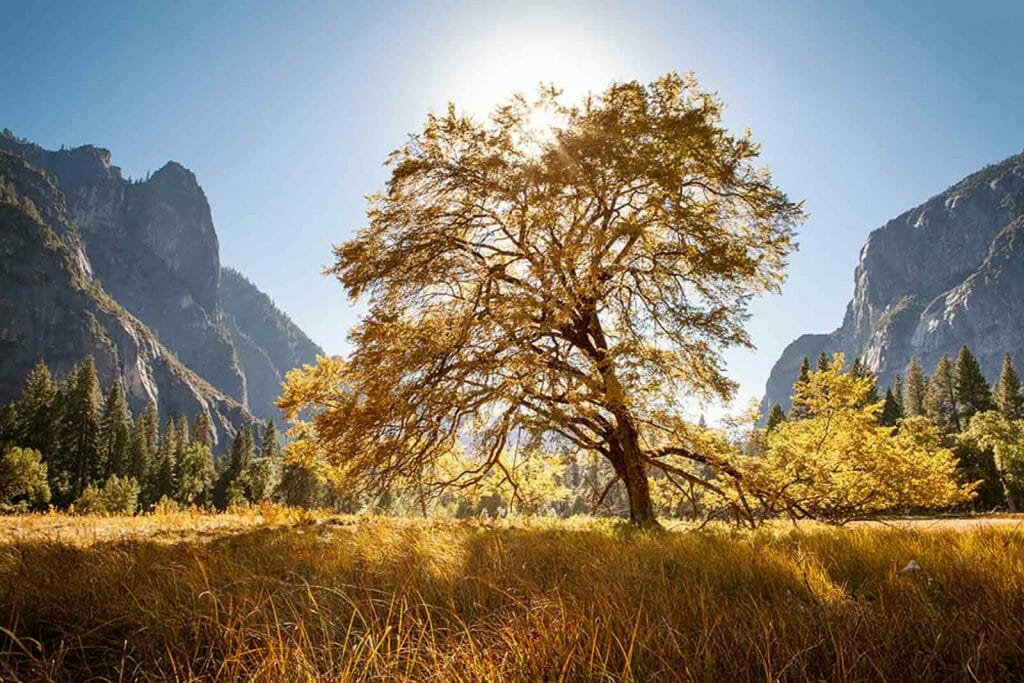
Foothill Forest (Altitude: 1,000 – 3,000 feet)
Valley Oak. The largest and fastest growing of the North American Oaks, the Valley Oak can grow 60-feet-tall in just 20 years, and reach up to 100-feet-tall with a base diameter of two or three meters. Its rigid, pewter-colored bark resembles alligator hide, wrapping irregular, broadly-spread, arching branches that host leaves from five to ten centimeters in length that are roundly and deeply lobed, with width that’s generally equal to half the leaf’s length. These matte green leaves are covered in a soft fuzz, a telltale of the valley oak.
Gray Pine. The solitary characteristic conifer of the Foothill Forest belt, the gray pine features many branches and airy foliage that makes for poor shade but beautiful silhouettes, courtesy of its stiff, slim, silvery-gray, needles. The digger pine’s crooked, often forked trunk is coarse-grained with loosely wrapped bark, and rarely growing higher than 60 feet tall. Perhaps the most distinguishing characteristic, other than an elevation unique among conifers, are its broad, oversized cones, which produce large, edible seeds from within.
Black Cottonwood. One of Yosemite’s most easily recognized broadleaved trees, the black cottonwood tends to grow abundantly along streams and river banks in Yosemite Valley, Wawona, and Hetch Hetchy. Young black cottonwoods, as well as the branches and upper trunk of mature ones, feature smooth, pale-gray bark, which turns dark gray, furrowed, and heavily ridged when aged. In older trees, the bark can be as much as two inches thick. These trees have a relatively short lifespan of around 90 years, but in that time they can grow up to 90 feet tall and two to three feet in diameter. The short, heavy, often upright branches usually only grow above the upper two-thirds of the trunk’s height, and their brittleness makes them susceptible to breaking off easily in wind or snow. The black cottonwood’s thick, veined, leathery leaves have fine teeth along the edges, and are broad at the base tapering to point at the tip. Before turning yellow and dropping in the fall, their spring leaves are shiny green on the upper side and silvery-white underneath, creating a shimmering illusion in the breeze.
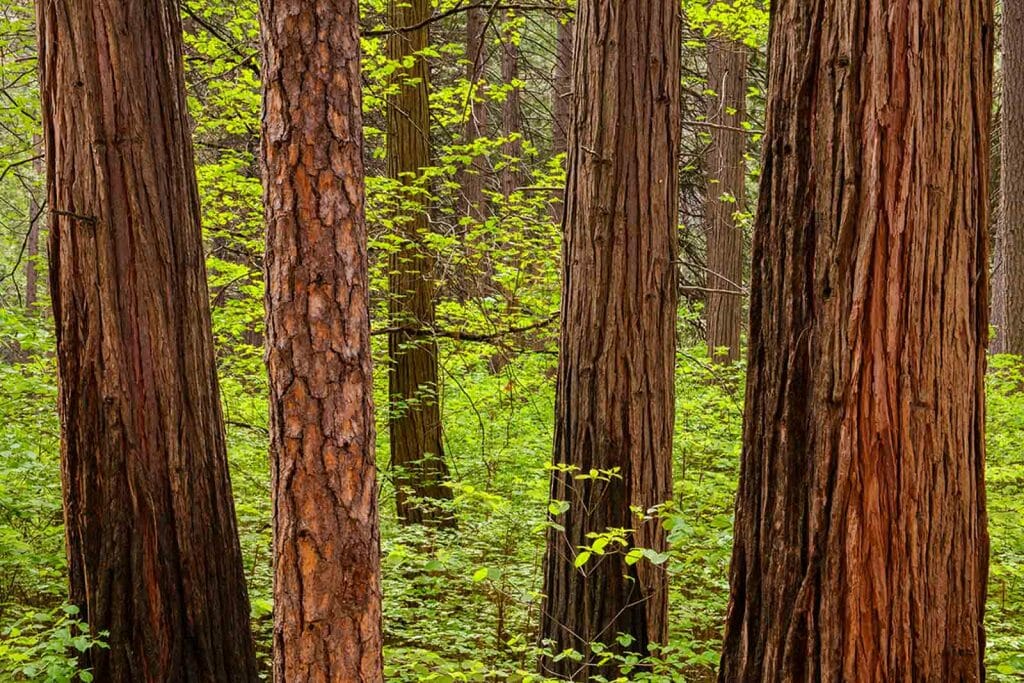
Main Timber Belt (Altitude: 3,000 – 7,000 feet)
Incense Cedar. Young incense cedars are among the most beautiful trees in Yosemite, growing in almost perfect symmetry with sides roughly twice as long as the wide bases, and tips terminating in sharp points. As they age, their impressive trunks take on an entirely different form with open, flat tops that are commonly dead, replaced by enormous branches that turn at right angles and grow upward, parallel to the trunk. On younger trees, their lower branches splay outward and down, while the upper branches reach toward the sky. The branches host spays of flat, vertically oriented foliage that extend over many branchlets and sag on the lower limbs of the tree. The deeply fissured, vertically ridged bark can be up to eight inches thick on mature specimens, with a shaggy characteristic and cinnamon-red color, making them easily mistaken for redwood trees (surprisingly to most, there are no true redwood trees in Yosemite). The finishing touch to their glory—Incense Cedar leaves and bark emit a distinct, fragrant aroma that earns this tree its name.
Californian Black Oak. Fully grown California Black Oaks typically range from 30 to 80 feet in height, though the largest may exceed 120 feet in height, with trunks up to 5 feet in diameter. This broad, spreading species produces large acorns (up to 3cm long and 2cm wide), with expansive limbs that stretch in all directions and require ample space to gather light. In a spacious climate, these oaks can sprawl as wide as 50 feet from limb to limb, with a rounded crown and lower limbs that drape low, often nearly kissing the ground. Its bark is thin and smooth in the early stages of its growth, but becomes thick, deeply fissured, and platy as the tree matures. The California Black Oak’s deciduous leaves are elliptic, lobed and green in Spring and Summer, turning golden, yellow or orange in Autumn before falling in a brilliant display of fall color.
Douglas Fir. Another of Yosemite’s conifers, from afar the Douglas Fir can be identified by its unique ability to dance; unlike other cone-bearers, it sways in even the slightest breeze, distinguishing it against its rigid neighboring conifers as it bends and leans in the wind, courtesy of its supple splays and flexible, spreading branches. Tall and thin with slender, drooping branchlets, Douglas Firs are often mistaken for other varieties, like Red Firs or Yellow Firs, though the Douglas’ botany is actually thought to be more closely related to hemlocks or spruces than firs. Its branchlets have short leaf stems that grow around the twigs in spirals, tending to be flat on horizontal branches, but evenly spaced on drooping branches, creating a full, rounded aesthetic. The needles are short, flat, glossy, light-green above, and gray-green beneath. In late-spring, tufts of new leaves appear vividly yellow-green and contrast strikingly with the older, darker foliage. In their youth, the Douglas Fir’s bark is whitish or ashy and smooth, but in time it matures to become fissured, ridged, rough and dark gray, with the broad faces of its ridges appearing dark brown against an ashy sheen on the sides of its deep fissures.
Sugar Pine. Known as the king of all pines, these massive, flat-topped trees can stretch from 180 to 240 feet high with branches of varied length and short leaves (usually 2 to 3 1/2 inches long) that arrange with 5-needle clusters. Quickly identifiable by their dwarfing size, these rigid, slender, sharp-pointed trees present their leaves in a deep blue-green color.
To confirm that a Sugar Pine is indeed a Sugar Pine, all one must do is find its cones—the largest pinecones in the world—which can be 14 to 24 inches long and clustered at ends of branches.
The Sugar Pine’s bark is thick, flaky, purplish-brown or reddish, deeply fissured. They usually take root at elevations ranging between 4,000 and 7,500 feet.
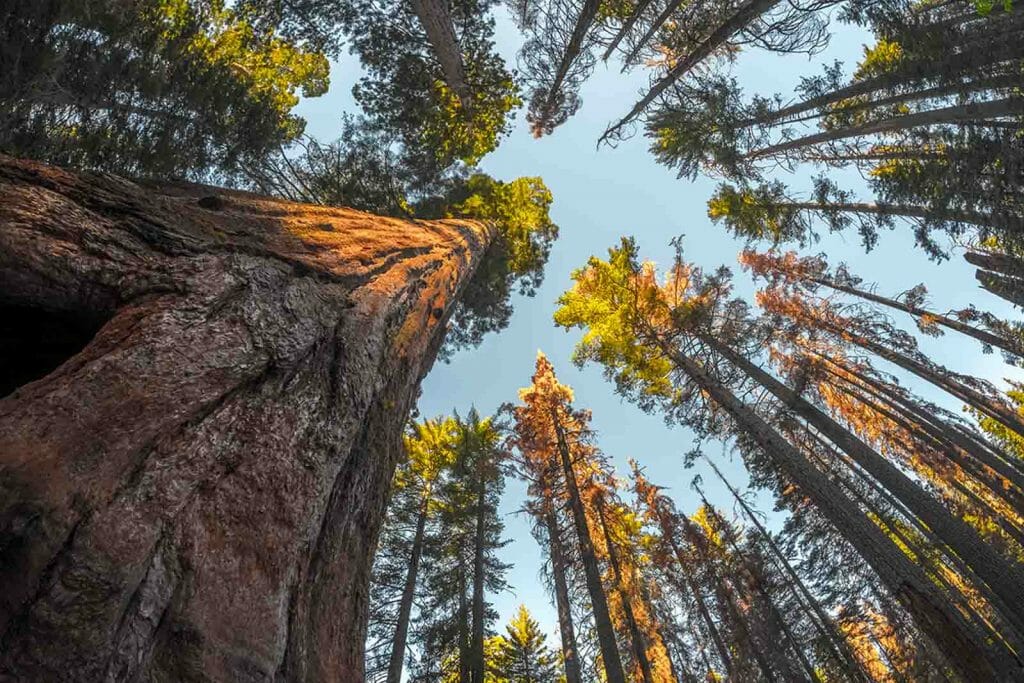
Giant Sequoia. Perhaps Yosemite’s most impressive and magnificent tree species, the Giant Sequoia—also known simply as “Big Trees”—are some of California’s last-standing old-growth bohemiths.
Giant Sequoias are the largest living beings on earth, reaching up to 300 feet tall and nearly 30 feet in diameter!
They are also some of earth’s oldest living specimens, with some that still stand after approximately 4,000 years of growth. Funnily enough, their egg-shaped cones are relatively dainty—only two or three inches long—though their cinnamon-red, fissured bark can be more than two feet thick along the monstrous trunks. Even to the untrained eye Giant Sequoia’s are easy to spot, made even more obvious by their tendency to grow in detached groves throughout the Sierra Nevada. Only three groves of Giant Sequoias remain in Yosemite today—the Mariposa, Merced, and Tuolumne Groves—where the ancient species have been protected against logging since their discovery by western cultures in the mid-1800s.
Ponderosa Pine. Also known as the Western Yellow Pine, Yosemite’s Ponderosa Pine is prolific throughout the park, a tall conifer that can reach 80 to 200 feet high. It can appear nearly identical to the Jeffery Pine, and in fact can hybridize with the Jeffery, so telling them apart can be a bit tricky. The main physical difference lies mostly in its location, with the Ponderosa generally residing at lower elevations (though there are plenty of exceptions), as well as in the scent (see the Jeffery Pine section below for a fun fact on that). Ponderosas are densely foliated, and can be distinguished quickly by their branch tips turning conspicuously upward. The leaves of a Ponderosa arrange in three-needle bundles, can range from four to 11 inches long, and are bright yellow-green. Their modestly sized cones are usually just three to five inches long, armed with scales and straight, slender prickles. The bark of young Ponderosas is typically brown, but more yellow on mature trees, and is arranged in massive, flaking plates resembling camouflage, or puzzle pieces. These are the arguably most dominant tree species in Yosemite Valley between altitudes of 3,500 to 5,500 feet.
Flowering Dogwood. The flowering dogwood, or mountain dogwood, is among the most floral and beautiful species within Yosemite’s Main Timber Belt. Commonly sighted throughout Yosemite Valley, but especially along the banks of the Merced River in the western half of the valley, flowering dogwoods typically bloom after reaching heights of 10 and 30 feet. Interestingly enough, the apparent “flowers” that earn these dogwoods their namesake are not single flowers, but clusters of mini flowers surrounded by petal-like bracts that bud with a greenish tint and bloom in snow-white bunches between April and June. Later in the year, these unique specimens are among the main contributors to Yosemite’s display of fall colors, showering the Valley and other areas in a constant drift of autumn color.
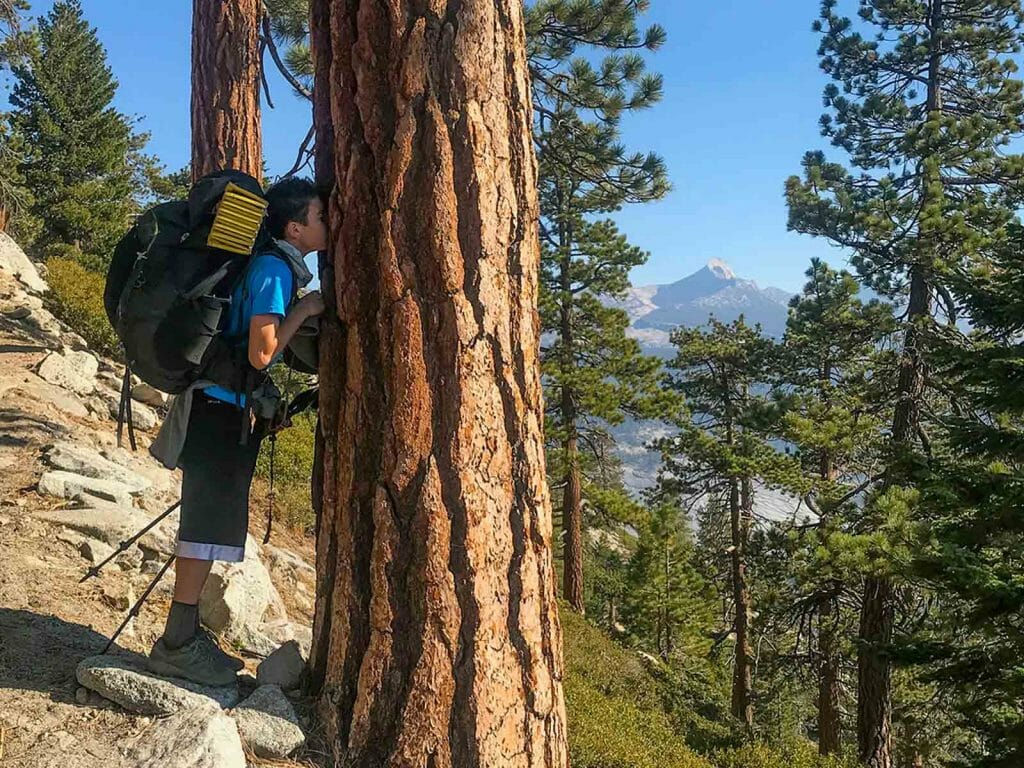
Sub-alpine Forest (Altitude: 7,000 – 11,000)
Lodgepole Pine. Yosemite’s only two-needled pine, the Lodgepole grows from Yosemite Valley to the tree line (around 11,000 feet), and is uniquely known to disperse among other species. Most commonly found between 7,000 and 10,000 feet, they are known to congregate with Western Junipers, Mountain Hemlocks, and White-bark Pines at elevations above 8,500 feet, whereas at lower elevations they can be found in large groves near filled-in river or lake bottoms. The lodgepole is tricky to distinguish from other pines in densely forested areas, while in less populated areas just below timber-line they are often distinctly small, flat-topped, and with multiple trunks, growing in groups. In these areas they often appear so differently from the forest Lodgepoles that they can be easily mistaken for different species. Generally ranging in height from 30 to 80 feet, the Lodgepole’s leaves are usually 1 to 2 1/2 inches long, stiff, flat, and bright yellow-green, surrounding cones with basal scales that remain closed when ripe. Their bark is grayish-yellow, thin and scaly.
Jeffery Pine. A perennial favorite of Lasting Adventures guests and guides alike, the Jeffery Pine is hardly distinguishable from other pines in the park, and is particularly resemblant of the Ponderosa Pine. But aside from finding homes at higher elevations than their doppelgänger, the Jeffery features one unique characteristic that separates it from all the rest.
To notice that Jeffery’s most defining characteristic requires observers to stick their noses deep into the fissures of its puzzle-like bark, and take a big whiff…
That’s right, the Jeffery’s main identifying trait is its smell, which graces the nostrils with a sweet, butterscotch-like scent. Thus, if you happen to witness someone apparently kissing a tree, it’s probably a Jeffery, and they’re probably smelling, not kissing.
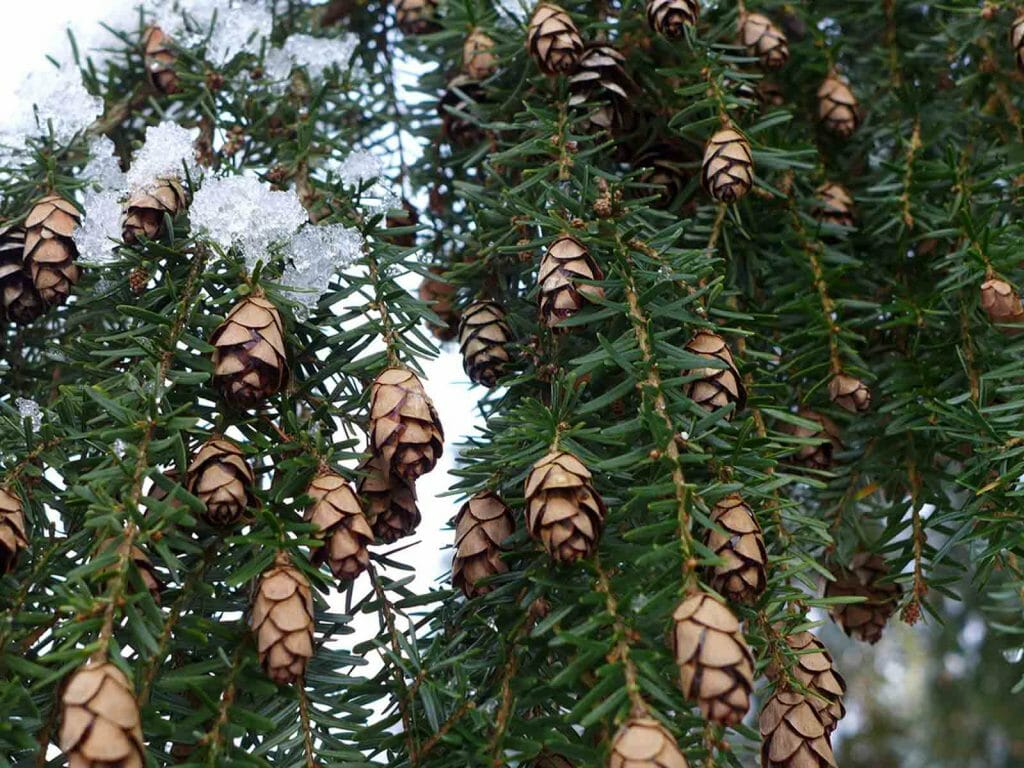
Mountain Hemlock. Pioneering naturalist and Yosemite legend, John Muir, once called the mountain hemlock “the most singularly beautiful of all the California coniferae,” probably because its light form provides a stark and enchanting contrast from other rugged conifers in its company. This cone-bearing beauty is characterized by a narrow crown that commonly extends 20 or more feet in height and less than a yard in width, with fragile tops distinguishable by their droop. While its upper branches push to the sky, the mountain hemlock’s lower branches are known to hang to the forest floor. It is often found surrounded by younger trees that cluster tightly at its base, partial to northern exposures at around 9,000 feet or more, where snow banks are preserved well into spring. From a distance, the deeply fissured bark has a bluish-gray hue that transforms into a deep reddish-brown upon closer look. Many consider the attempt to describe this tree’s beauty futile; as John Muir elegantly put it:

